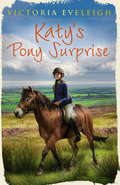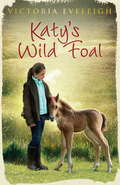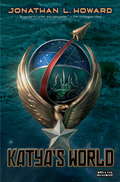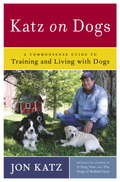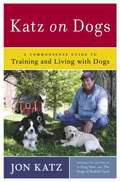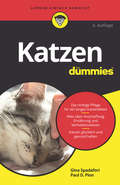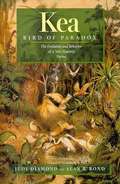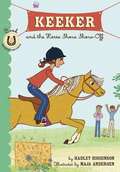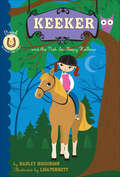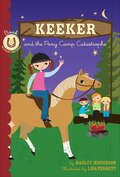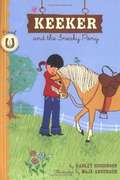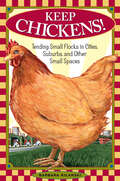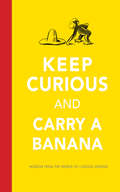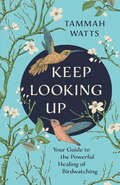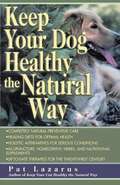- Table View
- List View
Katy's Pony Summer: Book 5 (Katy's Exmoor Ponies #5)
by Victoria EveleighThe latest adventure in Victoria Eveleigh's KATY'S EXMOOR PONIES series. Perfect for fans of pony and animal stories, Michael Morpurgo and Lauren St John.It's summertime at Barton Farm in Victoria Eveleigh's latest Exmoor adventure.Katy is looking forward to a carefree summer on the farm, riding and having fun with her best friend, Alice. But all that changes when an injured foal leads to a mystery that no one can solve.It's up to Katy and her friends to discover exactly what's going on.
Katy's Pony Summer: Katy's Exmoor Ponies 5 (Katy's Ponies Ser.)
by Victoria EveleighIt's summertime at Barton Farm in Victoria Eveleigh's latest Exmoor Pony adventure.Katy is looking forward to a carefree summer on the farm, riding and having fun with her best friend, Alice. But all that changes when an injured foal leads to a mystery that no one can solve. It's up to Katy and her friends to discover exactly what's going on.The latest adventure in Victoria Eveleigh's Exmoor Pony series. Perfect for fans of animal stories, Michael Morpurgo and Lauren St John.
Katy's Pony Surprise: Book 3 (Katy's Exmoor Ponies #3)
by Victoria EveleighKaty loves riding her pony, Trifle, and the two of them are constantly performing and showing off their new skills to Katy's family. But Trifle is full of surprises, and even Katy isn't prepared for the discovery in store for her at Christmas time . . .
Katy's Pony Surprise: Katy's Exmoor Ponies 3
by Victoria EveleighKaty loves riding her pony, Trifle, and the two of them are constantly performing and showing off their new skills to Katy's family. But Trifle is full of surprises, and even Katy isn't prepared for the discovery in store for her at Christmas time . . .
Katy's Wild Foal: Book 1 (Katy's Exmoor Ponies #1)
by Victoria EveleighKaty's birthday doesn't feel very special, until she discovers a tiny newborn foal on the moor. It walks right up to her with wobbly steps, and Katy is spellbound. As she reaches out and touches its forehead, Katy longs for the foal to be hers. But how will she ever persuade her family?
Katy's Wild Foal: Katy's Exmoor Ponies 1
by Victoria EveleighKaty's birthday doesn't feel very special, until she discovers a tiny newborn foal on the moor. It walks right up to her with wobbly steps, and Katy is spellbound. As she reaches out and touches its forehead, Katy longs for the foal to be hers. But how will she ever persuade her family?
Katya's World
by Jonathan L. HowardThe distant and unloved colony world of Russalka has no land, only the raging sea. No clear skies, only the endless storm clouds. Beneath the waves, the people live in pressurised environments and take what they need from the boundless ocean. It is a hard life, but it is theirs and they fought a war against Earth to protect it. But wars leave wounds that never quite heal, and secrets that never quite lie silent. Katya Kuriakova doesn't care much about ancient history like that, though. She is making her first submarine voyage as crew; the first nice, simple journey of what she expects to be a nice, simple career. There is nothing nice and simple about the deep black waters of Russalka, however; soon she will encounter pirates and war criminals, see death and tragedy at first hand, and realise that her world's future lies on the narrowest of knife edges. For in the crushing depths lies a sleeping monster, an abomination of unknown origin, and when it wakes, it will seek out and kill every single person on the planet.
Katya's World
by Jonathan L. HowardThe distant and unloved colony world of Russalka has no land, only the raging sea. No clear skies, only the endless storm clouds. Beneath the waves, the people live in pressurised environments and take what they need from the boundless ocean. It is a hard life, but it is theirs and they fought a war against Earth to protect it. But wars leave wounds that never quite heal, and secrets that never quite lie silent. Katya Kuriakova doesn't care much about ancient history like that, though. She is making her first submarine voyage as crew; the first nice, simple journey of what she expects to be a nice, simple career. There is nothing nice and simple about the deep black waters of Russalka, however; soon she will encounter pirates and war criminals, see death and tragedy at first hand, and realise that her world's future lies on the narrowest of knife edges. For in the crushing depths lies a sleeping monster, an abomination of unknown origin, and when it wakes, it will seek out and kill every single person on the planet.
Katz on Dogs
by Jon KatzIn a nation where our love of dogs keeps growing and dog ownership has reached an all-time high, confusion about dogs and their behavioral problems is skyrocketing. Many dogs are out of control, untrained, chewing up furniture, taking medication for anxiety, and biting millions of people a year. Now, in this groundbreaking new guide, Jon Katz, a leading authority on the human-canine bond, offers a powerful and practical philosophy for living with a dog, from the moment we decide to get one to the sad day when one dies. Conventional training methods often fail dog owners, but Katz argues that we know our dogs better than anyone else possibly could, and therefore we are well suited to train them. It is imperative, he says, that we think rationally and responsibly about how we choose, train, and live with the dogs we love, and the more we learn about ourselves, the better we can recognize their wonderful animal natures. Misinterpreting dogs is a profound obstacle to understanding them. Katz believes that both people and dogs are unique–a chow differs from a Lab just as a city dweller differs from a farmer–and he describes how such individuality isn’t addressed by even the best and most popular training methods. Not every training theory is for everyone, notes Katz, but almost anyone can train a dog and live with him comfortably. Katz on Dogs is filled with no-nonsense advice and answers to such key questions as: • What kind of dog should I have? Is there is a specific breed or kind of dog for my personality, family, or living situation? • What is the best way to train a dog? • Can I trust my vet? • How often (and for how long) can a dog be left alone? • Is it preferable to have only one dog, or are more better? • What are the secrets to successful housebreaking? • What are my dogs thinking, if anything? • How can I walk my dog instead of having her walk me? • Is it ever okay to give away a dog you love? • When is it time to put my dog down? Katz draws from his own experience, his interactions with thousands of dog owners, vets, breeders, dog rescue workers, trainers, and behaviorists, and he has tested his approach with volunteer dog owners around the country. Their helpful and often inspiring stories illustrate how all of us can live well with our dogs. You can do it, Katz contends. You can live a loving and harmonious life with your dog. From the Hardcover edition.
Katz on Dogs: A Commonsense Guide to Training and Living with Dogs
by Jon KatzIn a nation where our love of dogs keeps growing and dog ownership has reached an all-time high, confusion about dogs and their behavioral problems is skyrocketing. Many dogs are out of control, untrained, chewing up furniture, taking medication for anxiety, and biting millions of people a year. Now, in this groundbreaking new guide, Jon Katz, a leading authority on the human-canine bond, offers a powerful and practical philosophy for living with a dog, from the moment we decide to get one to the sad day when one dies. Conventional training methods often fail dog owners, but Katz argues that we know our dogs better than anyone else possibly could, and therefore we are well suited to train them. It is imperative, he says, that we think rationally and responsibly about how we choose, train, and live with the dogs we love, and the more we learn about ourselves, the better we can recognize their wonderful animal natures. Misinterpreting dogs is a profound obstacle to understanding them. Katz believes that both people and dogs are unique-a chow differs from a Lab just as a city dweller differs from a farmer-and he describes how such individuality isn't addressed by even the best and most popular training methods. Not every training theory is for everyone, notes Katz, but almost anyone can train a dog and live with him comfortably. Katz on Dogs is filled with no-nonsense advice and answers to such key questions as: What kind of dog should I have? Is there is a specific breed or kind of dog for my personality, family, or living situation? What is the best way to train a dog? Can I trust my vet? How often (and for how long) can a dog be left alone? Is it preferable to have only one dog, or are more better? What are the secrets to successful housebreaking? What are my dogs thinking, if anything? How can I walk my dog instead of having her walk me? Is it ever okay to give away a dog you love? When is it time to put my dog down? Katz draws from his own experience, his interactions with thousands of dog owners, vets, breeders, dog rescue workers, trainers, and behaviorists, and he has tested his approach with volunteer dog owners around the country. Their helpful and often inspiring stories illustrate how all of us can live well with our dogs. You can do it, Katz contends. You can live a loving and harmonious life with your dog.
Katzen für Dummies (Für Dummies)
by Gina Spadafori Paul D. Pion"Katzen für Dummies" bietet umfassendes und praktisches Wissen für Katzenbesitzer. Lernen Sie die verschiedenen Katzenrassen kennen und erhalten Sie Hilfe bei der Auswahl der richtigen Katze. Erfahren Sie nützliche Informationen zur Katzentoilette und Katzenklappe und zur Ernährung und Gesundheit Ihres Stubentigers. Gina Spadafori zeigt Ihnen, wie Sie Ihre Katze erziehen und gibt Tipps, wie Sie mögliche Verhaltensprobleme in den Griff bekommen. Mit diesem Buch werden Sie als Katzenhalter die Besonderheiten Ihrer Katze zu schätzen wissen.
Kaufman Field Guide to Nature of New England
by Kenn Kaufman Kimberly KaufmanWhether you're walking in the woods or along the beach, camping, hiking, canoeing, or just enjoying your own backyard, this book will help identify all your nature discoveries. With authoritative and broad coverage, using nontechnical and lively language, this guide is an essential reference for nature lovers living in or visiting New England.
Kazam's Birds
by Barney Saltzberg Amy EhrlichThere are some birds on Kazam. How can she make them fly away? A very easy book for your beginning reader!
Kea, Bird of Paradox: The Evolution and Behavior of a New Zealand Parrot
by Judy Diamond Alan B. BondThe kea, a crow-sized parrot that lives in the rugged mountains of New Zealand, is considered by some a playful comic and by others a vicious killer. Its true character is a mystery that biologists have debated for more than a century.
Keeker and the Horse Show Show-off
by Hadley HigginsonKeeker and her pony Plum enter their very first horse show, where they are confronted by much more experienced riders.
Keeker and the Not-So-Sleepy Hollow (Sneaky Pony Series #6)
by Hadley HigginsonKeeker and Plum are excited to visit family this summer, until they find out that a local town is haunted—by a headless horseman! When Keeker and Plum take a road trip to upstate New York, Keeker is sure it will be the best family vacation yet. (Plum, on the other hand, is not convinced!) Keeker is excited to splash in the neighborhood pond and ride ponies in the country with her cousins. What she doesn&’t know is that the nearby town of Sleepy Hollow holds a mystery that will make this a very ghostly getaway! Praise for the Sneaky Pony series &“These books are terrific first chapter books for young readers, quirky and compelling; the line drawings of the girl and her horse are simple but beguiling.&” —Entertainment Weekly &“I don&’t bandy the word &‘delightful&’ around lightly, but the retro flavor with contemporary appeal wins the Delightful Derby, and I am so happy to be able to recommend a romp down a reading trail that little girls will really enjoy.&” —PlanetEsme
Keeker and the Pony Camp Catastrophe: Book 5 in the Sneaky Pony Series (Sneaky Pony Series #5)
by Hadley HigginsonJust when summer starts to seem not so sunny, a crazy adventure mends fences between Keeker and Plum and their arch rivals. Keeker and Plum get to go to sleepaway camp for a whole week. But fun turns to surprise when Keeker learns that her bunkmate is none other than her horse-show rival, Tifni. The girls put aside their differences and become fast friends, but when Tifni&’s spirited pony bolts, Keeker has to decide whether to play it safe or save her friend. Praise for the Sneaky Pony series &“These books are terrific first chapter books for young readers, quirky and compelling; the line drawings of the girl and her horse are simple but beguiling.&” —Entertainment Weekly &“I don&’t bandy the word &‘delightful&’ around lightly, but the retro flavor with contemporary appeal wins the Delightful Derby, and I am so happy to be able to recommend a romp down a reading trail that little girls will really enjoy.&” —PlanetEsme
Keeker and the Sneaky Pony
by Hadley HigginsonWhen eight-year-old Keeker gets a pony, she is faced with the challenge of winning the animal's trust and friendship, and they both come to understand the phrase "You scratch my back and I'll scratch yours."
Keeker and the Sneaky Pony: Book 3 In The Sneaky Pony Series (Sneaky Pony Series #1)
by Hadley HigginsonSaddle up for a wild ride when a young girl finally gets the pony she&’s always dreamed of—and has some misadventures she never could have imagined. Meet Catherine Corey Keegan Dana (everyone calls her Keeker). What she wants most of all is a pony. Meet Plum. Plum is a Shetland pony (who&’s known to be a teeny bit sneaky). She rarely, if ever, thinks about little girls. She certainly doesn&’t want one. When Plum moves to Keeker&’s farm, Keeker faces the challenge of winning a pony&’s trust and friendship. And when Plum and Keeker find themselves lost in the woods, they learn that working together is the best way to get out of a fix. This fast-paced story of adventure and friendship will have new readers galloping back for more. &“Sepia-toned art and type give this tale a pleasingly old-fashioned yet timeless feel. The ample full-page and spot illustrations plus short sentences tailor this early chapter book to reluctant readers—particularly those with a soft spot for horses.&” —Publishers Weekly
Keep Chickens!: Tending Small Flocks in Cities, Suburbs, and Other Small Spaces
by Barbara KilarskiNo matter how small your lot is, you can keep chickens and enjoy fresh eggs every morning. Barbara Kilarski shares her passion for poultry as she fills this guide with tips and techniques for successfully raising chickens in small spaces. Spotlighting the self-sufficient pleasures of tending your own flock, Kilarski offers detailed information on everything from choosing breeds that thrive in tight quarters and building coops to providing medical care for sick animals. You’ll have fun as you keep happy and productive chickens.
Keep Curious and Carry a Banana: Words of Wisdom from the World of Curious George (Curious George)
by H. A. Rey Justin Martin Liza CharlesworthFor more than seventy-five years, the world of Curious George has delighted readers with its playful charm and deceptively simple wisdom. Fans of the Keep Calm and Carry On craze will find comfort in this Georgified version of the popular book format. Each inspiration is humorously accompanied by an illustration from the original works of H. A. Rey’s Curious George books. Sure to make readers chuckle as only George can, this book is packed with inspiration and humor. It's the perfect gift for all the curious people in your life!
Keep Looking Up: Your Guide to the Powerful Healing of Birdwatching
by Tammah WattsA BIRDING JOURNEY AT HOME AND BEYONDIt began with a flutter of yellow feathers flitting through the trees, casting beams of sunshine and promise that burst through her kitchen window. This was her sign to look up.As a licensed therapist, Tammah Watts knew that she needed to seek and accept hope, love, and support to overcome her chronic pain and cultivate resilience. But she could not predict that the little yellow bird would put her on the path to healing by fostering a powerful connection with birds and the experience of birding.Tammah shares her emotional journey of finding comfort and inspiration from her feathered friends, while providing practical tips and tools to help you:Explore the practice of birdwatching from the comfort of your own home and community Increase your self-awareness, mindfulness, and concentrationFind acceptance and alignment with the spirit and beauty of birdsRight outside your door flies just what you&’ve been looking for to help ease symptoms of stress, pain, depression, and anxiety. All you have to do is look up, take notice, and open your heart and mind.No matter where you are, what you look like, or what you're going through, you can create sacred space and connection with birds and begin to heal.
Keep Out, Pony! (Pony Pals #12)
by Jeanne BetancourtPony Pal Trail is special to all the Pony Pals. The trail connects Pam's backyard to the pony paddock Anna and Lulu share. But now everything has changed. New neighbors have built a sheep pen that blocks the trail. What will the Pony Pals do now?
Keep Your Cat Healthy The Natural Way
by Pat LazarusFor those who need to learn how to really care for cats. An excellent resource and guide.
Keep Your Dog Healthy the Natural Way
by Pat LazarusMillions of people who use holistic techniques on themselves are now discovering they can apply these same powerful practices to their canine companions for a longer, healthier life.

